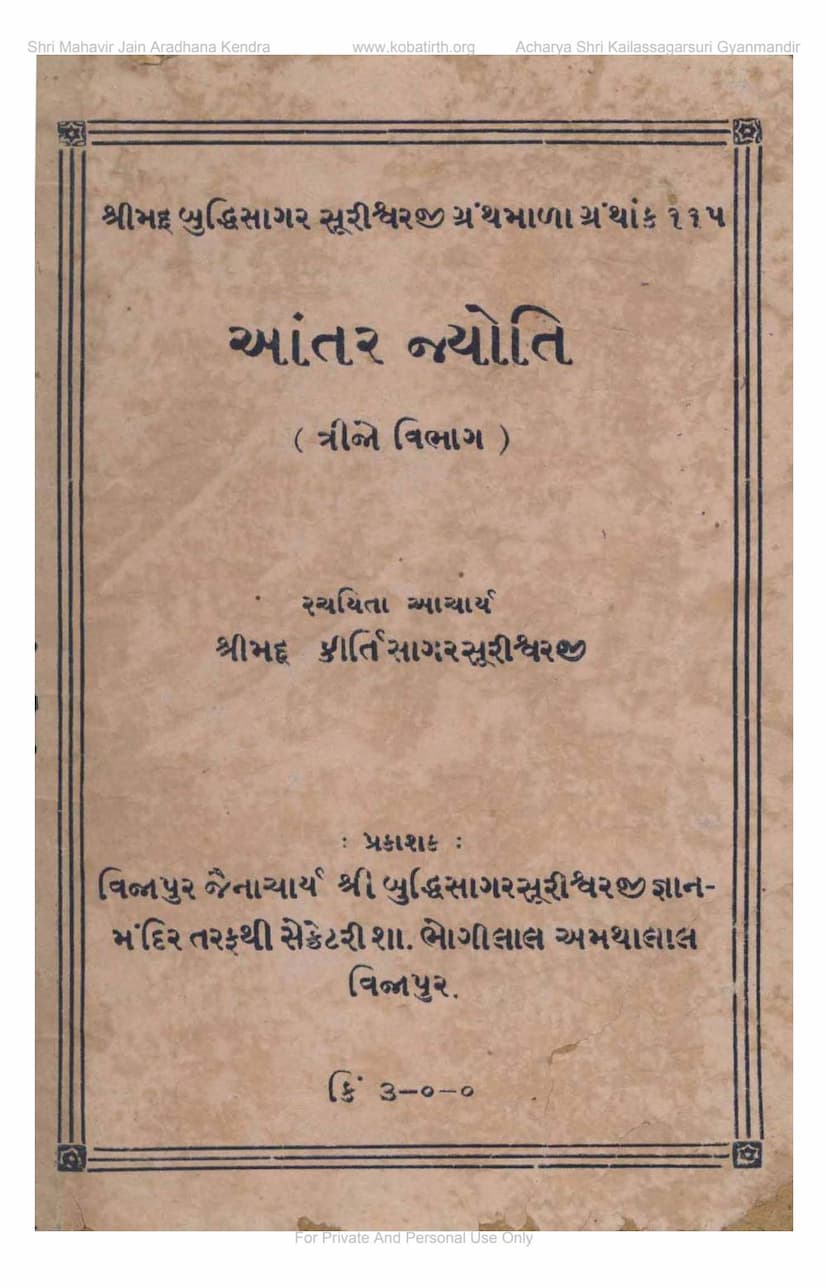Antarjyoti Part 3
Added to library: September 1, 2025

Summary
This Jain text, "Antarjyoti Part 3" (Inner Light, Part 3) by Acharya Shrimad Kirtisagarsuri, published by Adhyatma Gyan Prasarak Mandal, is a spiritual discourse aimed at guiding individuals towards inner enlightenment and a better life, both materially and spiritually. It is part of a larger series, being volume 115 in the Shrimad Buddhisagar Surishwarji Granthamala.
The book, written in Gujarati, emphasizes the importance of right knowledge, right perception, and right conduct (Samyak Darshan, Samyak Gyan, and Samyak Charitra) in overcoming worldly suffering and achieving spiritual liberation. The author, Acharya Kirtisagarsuri, through various parables, examples, and philosophical discussions, highlights key principles of Jainism and ethical living.
Here's a breakdown of the core themes and messages conveyed throughout the text:
1. The Value of Human Life and the Perils of Misdirection:
- The text begins by lamenting the misuse of human life, which is considered rare and precious. It criticizes spending time on fleeting pleasures, desires, and worldly pursuits, warning that this leads to rebirth in lower forms of existence and suffering.
- It stresses the need to use intellect to overcome desires and passions, which obscure true understanding.
2. The Pursuit of True Happiness vs. Illusory Worldly Pleasures:
- The book contrasts true, lasting happiness derived from inner knowledge and self-realization with the temporary and ultimately unsatisfying pleasures of the material world.
- It criticizes attachment to possessions, reputation, and worldly affairs, which lead to anxieties, worries, and suffering.
3. The Power of Knowledge, Conduct, and Devotion:
- Right Knowledge (Samyak Gyan): Understanding the true nature of reality, the soul, karma, and the path to liberation is paramount. Ignorance (ajnanata) is identified as the root of suffering.
- Right Conduct (Samyak Charitra): This involves adhering to ethical principles, practicing self-control, avoiding harm to living beings (Ahimsa), and cultivating virtues like truthfulness, non-stealing, chastity, and non-possessiveness. The text emphasizes the importance of practices like Samayik (meditation/equanimity) as exemplified by Punyashravak.
- Devotion (Bhakti): The text highlights the importance of devotion to the Tirthankaras, Gurus, and the Dharma, emphasizing sincere and selfless service.
4. Overcoming Negative Tendencies and Cultivating Virtues:
- The book extensively discusses the dangers of negative emotions and tendencies like anger (krodh), pride (man), deceit (maya), greed (lobha), envy (irshya), and attachment (raag).
- It advocates for cultivating positive virtues such as forgiveness (kshama), humility (namrata), contentment (santosh), equanimity (samata), compassion (karuna), and perseverance.
5. The Role of Examples and Parables:
- Throughout the text, numerous stories and parables are used to illustrate the principles. Examples like the shepherd with the Chintamani jewel, the story of Shrimal (Shravak), the doctor's selfless service, the king's pride, the merchant's greed, the tale of the poisonous laddu, the importance of right conduct, the story of the shrewd businessman, the patient's plight, the learned judge and the mute person, the wise man and the monkey, and many others serve as powerful teaching tools.
6. The Importance of Self-Reflection and Right Intention:
- The text repeatedly urges readers to introspect, understand their own faults, and strive for self-improvement. It emphasizes that external actions without the right inner intention are futile.
- The concept of "Antarjyoti" (Inner Light) itself signifies the focus on internal transformation.
7. Practical Guidance for Daily Life:
- The book offers practical advice on managing desires, controlling the senses, making wise choices, fostering good relationships, and living a virtuous life.
- It touches upon the proper use of wealth, the dangers of addiction, the importance of sincerity, and the consequences of deceit.
8. The Cycle of Karma and Liberation:
- While not explicitly detailing the intricacies of Jain cosmology, the underlying theme is the law of karma. Actions (karma) lead to consequences, and by following the path of righteousness, one can mitigate suffering and work towards liberation (moksha).
Key Takeaways:
- Live with Purpose: The human life is a gift, meant for spiritual growth and self-realization, not mere material indulgence.
- Cultivate Inner Virtues: True happiness comes from cultivating inner qualities like knowledge, compassion, humility, and self-control, not from external possessions.
- Discernment is Crucial: One must cultivate wisdom to distinguish between what is real and eternal (the soul) and what is transient and illusory (material possessions).
- Self-Reflection and Correction: Constant introspection and the correction of one's own faults are essential for spiritual progress.
- The Power of Right Association: Associating with the virtuous and wise (Satsang) is vital for spiritual upliftment.
- Be Mindful of Actions: Every action, thought, and word has consequences. Acting with mindfulness and ethical consideration is crucial.
- The Path of Non-Attachment: Ultimately, detachment from worldly desires and possessions leads to lasting peace and liberation.
In essence, "Antarjyoti Part 3" serves as a comprehensive spiritual guide, encouraging readers to turn their focus inward, understand their true nature, and live a life aligned with Jain principles to achieve both worldly well-being and ultimate spiritual freedom. The text is rich with practical wisdom and ethical teachings, making it a valuable resource for spiritual seekers.